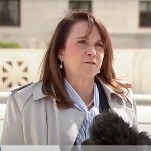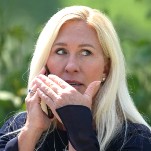How Bill O'Reilly Became 'Worst of All'
LatestAt 67-years-old, Bill O’Reilly has been with us, doing what he does, for so long that its hard to remember a time in which he wasn’t. He is the mole on your back that doesn’t seem to be cancerous but you can’t see it and your dermatologist told you it has weird edges. He is your insistence on drinking skim milk that could just taste like the absence of fat but also might have gone bad. He may not kill you, but he will most certainly not make you stronger.
O’Reilly was born in 1949, and grew up, now famously, in Levittown, Long Island, an upbringing he has written at length about, and which was covered extensively in Marvin Kitman’s book The Man Who Would Not Shut Up: The Rise of Bill O’Reilly. (A few years back, O’Reilly and Al Franken memorably and publicly sparred over whether O’Reilly had actually grown up in Levittown or in the more affluent nearby neighborhood of Westbury.) He describes himself as “working-class Irish American,” and was raised Catholic, matriculating at Marist College, before getting a Master’s in Broadcast Journalism from Boston University.
Starting in 1979, he worked at a number of stations, slowly working his way up from local news, winning a few local Emmys in the process, before getting gigs at CBS News and ABC News. No reports of O’Reilly’s behavior written at the time make him seem like a particularly noteworthy talent; in 1983, the Vice President of Programming of the local new channel he worked for called him “bright and creative—someone who has a background in news, but is flexible enough to handle the kind of range required in a program which calls for a strong personality and spontaneous response.”
As such, at this point in time, it does not appear that any of his news coverage seemed notably slanted; if it was, it has been lost to the sands of time. But in 1989, O’Reilly got the break that would change things for him, and for us, his audience: a job at Inside Edition. He would eventually become the host of the show, which is where he began to make his mark on a national level. A December 1992 AP article sings his praises, describing him as an “intense, driven anchor” who “manages to look rangy and intense, kind of halfway between comedians Tom Hanks and Bill Murray.” While in that role, O’Reilly’s show regularly competed with Fox’s A Current Affair, and he had grandiose plans for it, telling the AP that he planned to “pass Tom Brokaw in the ratings.”
It was at this point that his more traditional news background melded with his new tabloid-esque sensibilities, an emphasis on informing and entertaining, and an ability to get people to stay watching that would serve him well at Fox. From that same interview:
“What we’re doing here has changed television and will continue to change television more, and people don’t understand it,” he said.
…
“That’s what drives our show: Emotion. All of our stories are emotion-driven. If they don’t have emotion, we don’t do ‘em,” O’Reilly said.
“That emotion has changed the way the viewer looks at the news. And the viewer doesn’t understand it.
In the ’90s, O’Reilly was part of the rise of so-called tabloid journalism, combining commentary with reporting. This resulted in high-profile sparring with Dan Rather in the pages of The New York Times, over things like whether paying for sources was appropriate. But in 1994, O’Reilly was replaced with Deborah Norville at Inside Edition. He said that he was working on a book about the television world (which would become the thriller Those Who Trespass) and considering a run for Congress, and he spent time at the Harvard Kennedy School. Two years later, he’d get his big break: his own show on Roger Ailes’s new 24/7 news network Fox News. It seems funny (funny in that, you’re laughing so hard you can’t breathe and then actually think you might want to die way) to think of now, but at the time, whether or not Fox would be distinctly conservative was still up for debate. From the Times:
Will FNC be a vehicle for expressing Mr. Murdoch’s conservative political opinions?
Many journalists believe Mr. Murdoch wants to offer a conservative alternative to what he views as liberal bias among traditional news purveyors. Reinforcing their belief is the fact that the new network’s chairman and chief executive is Roger Ailes, the well-known former Republican political strategist.
While Mr. Murdoch concedes that he sees a liberal bias in television news, and cites opinion polls showing that many Americans agree with him, he stops just short of championing an explicitly conservative alternative. He says he wants his network to label analysis and opinion to clearly distinguish it from news, and to be ‘’fair and balanced’’ in reporting.
From the beginning, O’Reilly’s show (originally called The O’Reilly Report, before being renamed The O’Reilly Factor) was primarily a place for him to discuss topics he thought were “worthy of attention.”
On opening night they included drugs and the Presidential debate. Heavy stuff, but the next night brought the actress Cheryl Ladd plugging a book. Mr. O’Reilly seemed just as interested in Ms. Ladd as in the election. It’s that sort of show.
As Howard Kurtz explained it in the Washington Post in October of 1996, though he said horrible things, O’Reilly got points for allowing others to get a word in after he said them:
Former “Inside Edition” host Bill O’Reilly brings plenty of attitude to his show. To the minister of murdered rapper Tupac Shakur, he said: “A lot of people say that man did a lot of evil.” To gay rights activist Candace Gingrich, he said: “Most Americans think homosexuality is wrong.” But O’Reilly gives his guests plenty of room to respond.
And as O’Reilly wrote in an op-ed that year that examined the failures of TV news, his interest has always been a highly specific focus on “examin[ing] the lives of ordinary Americans who are succeeding or failing in their endeavors.”
-

-

-

-

-

-

-

-

-

-

-

-

-

-

-

-

-

-

-

-

-

-

-

-

-

-

-

-

-

-

-

-

-

-

-

-

-

-

-

-








































